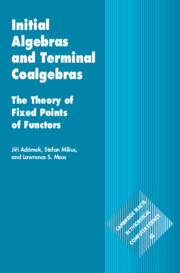Refine search
Actions for selected content:
48571 results in Computer Science
Experiences of early assessment to teach functional programming
- Part of
-
- Journal:
- Journal of Functional Programming / Volume 35 / 2025
- Published online by Cambridge University Press:
- 03 February 2025, e4
-
- Article
-
- You have access
- Open access
- HTML
- Export citation
LEIBNIZ’S MEREOLOGY: A LOGICAL RECONSTRUCTION
- Part of
-
- Journal:
- The Review of Symbolic Logic / Volume 18 / Issue 2 / June 2025
- Published online by Cambridge University Press:
- 03 February 2025, pp. 636-670
- Print publication:
- June 2025
-
- Article
-
- You have access
- Open access
- HTML
- Export citation

Defeating Disinformation
- Digital Platform Responsibility, Regulation and Content Moderation on the Global Technological Commons
-
- Published online:
- 30 January 2025
- Print publication:
- 06 February 2025
-
- Book
-
- You have access
- Open access
- Export citation

Initial Algebras and Terminal Coalgebras
- The Theory of Fixed Points of Functors
-
- Published online:
- 30 January 2025
- Print publication:
- 06 February 2025
ROB volume 42 issue 11 Cover and Front matter
-
- Article
-
- You have access
- Export citation
A systematic review of regulatory strategies and transparency mandates in AI regulation in Europe, the United States, and Canada
- Part of
-
- Journal:
- Data & Policy / Volume 7 / 2025
- Published online by Cambridge University Press:
- 30 January 2025, e11
-
- Article
-
- You have access
- Open access
- HTML
- Export citation
Worst-case performance for real-time systems
-
- Journal:
- Research Directions: Cyber-Physical Systems / Volume 3 / 2025
- Published online by Cambridge University Press:
- 30 January 2025, e2
-
- Article
-
- You have access
- Open access
- HTML
- Export citation
CONSERVATION AS TRANSLATION
- Part of
-
- Journal:
- The Review of Symbolic Logic / Volume 18 / Issue 1 / March 2025
- Published online by Cambridge University Press:
- 30 January 2025, pp. 316-348
- Print publication:
- March 2025
-
- Article
-
- You have access
- Open access
- HTML
- Export citation
ROB volume 42 issue 11 Cover and Back matter
-
- Article
-
- You have access
- Export citation
Majoritarianism and Monoculture (M&M)
-
- Journal:
- Data & Policy / Volume 7 / 2025
- Published online by Cambridge University Press:
- 28 January 2025, e10
-
- Article
-
- You have access
- Open access
- HTML
- Export citation
On perfect subdivision tilings
- Part of
-
- Journal:
- Combinatorics, Probability and Computing / Volume 34 / Issue 3 / May 2025
- Published online by Cambridge University Press:
- 27 January 2025, pp. 421-444
-
- Article
- Export citation
Synthetic users: insights from designers’ interactions with persona-based chatbots
-
- Article
-
- You have access
- Open access
- HTML
- Export citation
Machine learning models for sequential motion recognition in human activity for logistics operations efficiency improvement
-
- Article
-
- You have access
- Open access
- HTML
- Export citation
Time series predictions in unmonitored sites: a survey of machine learning techniques in water resources
- Part of
-
- Journal:
- Environmental Data Science / Volume 4 / 2025
- Published online by Cambridge University Press:
- 22 January 2025, e7
-
- Article
-
- You have access
- Open access
- HTML
- Export citation
Hypergraph independence polynomials with a zero close to the origin
- Part of
-
- Journal:
- Combinatorics, Probability and Computing / Volume 34 / Issue 4 / July 2025
- Published online by Cambridge University Press:
- 22 January 2025, pp. 486-490
-
- Article
- Export citation


































